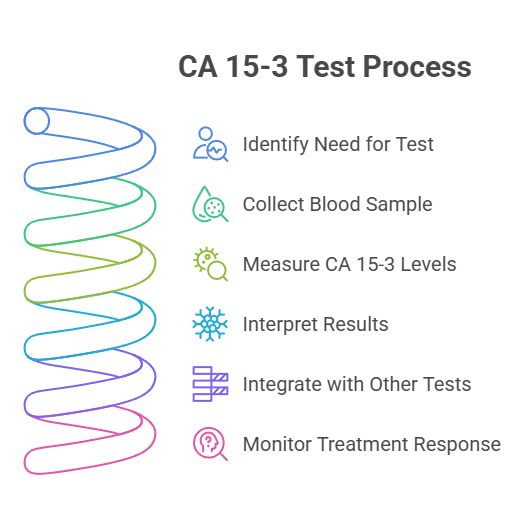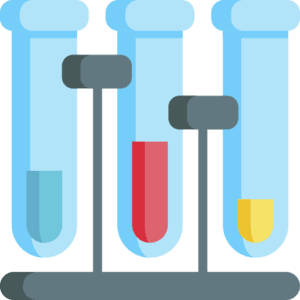
What is the CA 15-3 Test?
The CA 15-3 test measures the level of cancer antigen 15-3 in your blood, a substance that triggers your body’s immune response. Certain cancer cells release CA 15-3 into the bloodstream. Primarily, this test is employed to monitor specific cancer types, with breast cancer being the most common 1.
CA 15-3 is a tumour marker primarily used to monitor the effectiveness of breast cancer treatment and detect recurrence, especially in advanced stages. Not all breast cancers increase CA 15-3 levels, making it less useful for early-stage disease. This test is often part of a broader diagnostic approach, including hormone receptor and HER2 status testing, to provide a comprehensive assessment of the cancer’s behaviour and treatment response.
About CA 15-3 test
Learn everything about the breast cancer marker CA 15-3 test, before you book a lab test online. Understand the why, how, and what of this test.
Why Do Doctors Recommend CA 15-3 test?
You need a CA 15-3 blood test if you’ve been diagnosed with breast cancer, as it helps assess how effectively your treatment is working.
Additionally, if you’ve previously undergone treatment for breast cancer, this test is crucial to determine whether the cancer has returned or spread.
How To Prepare For the CA 15-3 Test?
The steps below help you ensure that your CA 15-3 test provides the most accurate information about your health.
- Medication guidelines: Tell your healthcare provider about all the drugs, supplements or herbal remedies you are taking, as some substances may affect test results. Follow any specific instructions regarding drug adjustment before testing.
- Contact the doctor: Share your entire medical history with existing conditions or symptoms to help explain test results.
What Happens During CA 15-3 Testing?
A CA 15-3 Test only takes a few minutes.
- As per the scheduled time of the blood test, a Lab Technician who usually takes blood samples will arrive.
- A thin needle will be used to draw blood from your arm’s vein.
- The needle might cause a mild pinch and some discomfort.
- The lab technician then fills a collection tube with blood and then removes the needle from the skin.
- They place a small bandage on the arm
Please note: There might be slight pain or bruising at the spot of insertion, but most of the symptoms go away quickly.
Finding CA 15-3 Test
Should you book blood test online to check your health condition or go to the nearest clinic and get it done by a medical professional? Let’s Find Out
Can I Take a CA 15-3 Test At Home?
Yes, the CA 15-3 Test can be taken at home. HealthcareOnTime’s at-home lab testing service, in association with thyrocare, provides a convenient and efficient way to get blood testing done from the comfort of your own home without the need for a doctor’s visit or a trip to a lab. It’s important to note that it’s always a good idea to consult with an expert healthcare provider about any queries you may have about your test results.
How Much Does CA 15-3 Test Cost?
The CA 15-3 test price varies significantly depending on many factors:
- Location: The CA 15-3 test prices in India may vary depending on the city or the region in which the test is conducted. For example, in Bangalore or Mumbai, it might be expensive as compared to small towns.
- Type of facility centres: The CA 15-3 test charge also varies between private hospitals, government hospitals, and diagnostic centres. Cost is lower in government hospitals as compared to private ones.
- Healthcare centres: Diagnostic centres, laboratories and hospitals may have different CA 15-3 test prices. It depends upon the benefits and reputation of the healthcare centre.
- Insurance Coverage: Individuals with health insurance can cover partial or all costs depending on their policy coverage and network providers.
- Additional services: Additional services such as home sample collection, express test results, or additional charges for special management may be paid, which contributes to the overall CA 15-3 test price.
Generally, the CA 15-3 test cost in India ranges from Rs. 1000 to Rs. 10000. By opting for HealthcareOnTime lab test at-home facilities, you can access the CA 15-3 test at the cost of INR 729.
Test Results Interpretation
You received your CA 15-3 test results but still need help determining if they fall under the normal range. Read this section to know if your results range between the CA 15-3 normal value or higher.
What Does CA 15-3 Test Results Mean?
Generally, the higher the CA 15-3 level, the more cancer is present in the body. The levels are typically highest when breast cancer has spread to the bones or liver 2.
- If your CA 15-3 level decreases or returns to normal, it may mean your treatment is working. An increase in CA 15-3 overtime could indicate your cancer is not responding well to treatment, is still growing, or has recurred.
- CA 15-3 can also be elevated in some non-cancer conditions like endometriosis, pelvic inflammatory disease, liver disease, and pregnancy. However, the levels are usually not as high and do not continue increasing over time as they can with cancer 3.
What Is the normal range for the CA 15-3 test?
Levels | Interpretation | Conditions |
More than 30 U/mL4 | CA 15-3 blood test Mild to moderate range | Cancer of the breast, lung, pancreas, ovary, and prostate as well as endometriosis, pelvic inflammatory disease or pregnancy 5. |
Less than or equal to 30 U/mL. | CA 15-3 blood test normal range | – |
What Medical Conditions Can Cause High CA 15-3 Levels?
High levels of CA 15-3 cancer marker test indicate the presence or spread of breast cancer, but they can also be caused by benign conditions of the breast, ovary, liver, lung, and gastrointestinal tract.
What Medical Conditions Can Cause Low CA 15-3 Levels?
Low levels of CA 15-3 are generally considered normal and are not typically associated with specific medical conditions 6. In the context of monitoring breast cancer, lower or decreasing levels of CA 15-3 are usually seen as a positive sign, indicating that the treatment may be effective or that the cancer is in remission.
More Related Tests
Why To Book with HealthCareOnTime

17 Crores+ Samples Processed

World Class Technology Labs

25+ Years of Trust & Experience

Free Home Collection
FAQs Around CA 15-3 Test
What is CA 15.3 test used for?
The CA 15.3 test is used to measure the level of cancer antigen 15-3 (CA 15.3), a protein produced by some types of breast cancer cells. The test is primarily used to monitor the treatment of breast cancer and to assess the risk of recurrence.
How is CA 15.3 test performed?
The CA 15.3 test is performed by taking a blood sample, usually from a vein in the arm, and sending it to a laboratory for analysis. The procedure is quick, simple, and painless.
What are normal results of CA 15.3 test?
The reference values for CA 15.3 test vary based on the laboratory, but generally, a CA 15.3 level of less than 31 U/mL is considered normal. However, it is important to note that normal values may vary depending on the patient’s age, sex, and overall health.
How reliable is CA 15.3 test?
The reliability of the CA 15.3 test varies, and false-positive and false-negative results are possible. The test is not used to diagnose breast cancer but rather to monitor the treatment of breast cancer in women who have already been diagnosed. The results should be interpreted in conjunction with other tests and examinations.
Are there any side effects of CA 15.3 test?
The CA 15.3 test is a simple blood test and has no significant side effects. The procedure is quick, simple, and painless.
How often should I get a CA 15.3 test done?
The frequency of CA 15.3 testing is determined by your healthcare provider based on your individual case. It is typically performed regularly to monitor the treatment of breast cancer and assess the risk of recurrence.
Is the CA 15.3 test expensive?
The Ca 15.3 test cost is Rs.750, although it is now available for Rs.721 because of the offer.












